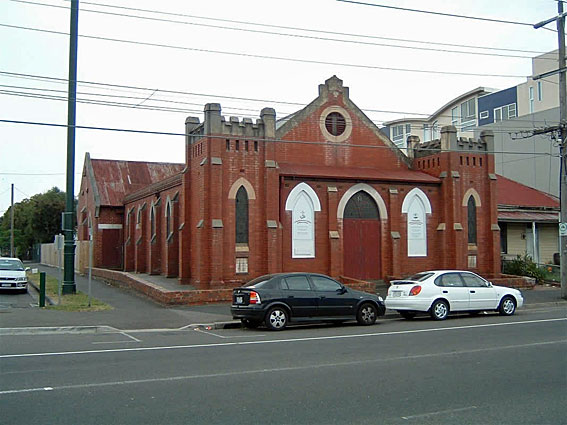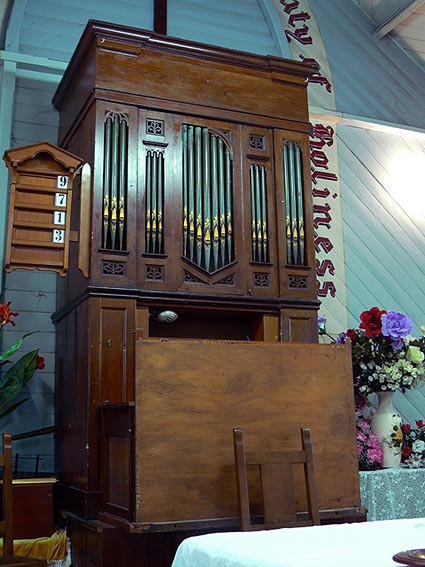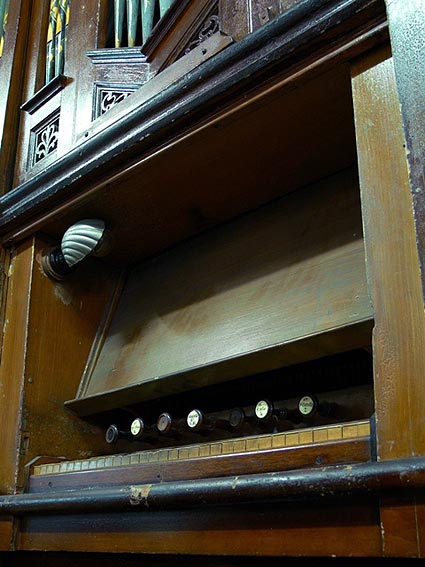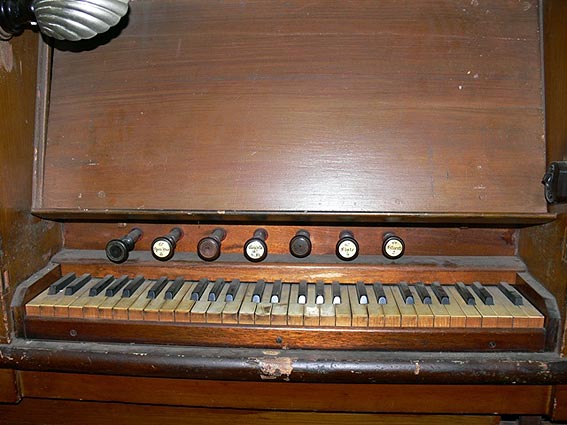
Congregational Church, Burnley
(photograph from website http://www.buickcarclub.org.au/index.php?ID=26 accessed 30 January 2017)

Congregational Church, Burnley
(photograph from website http://www.buickcarclub.org.au/index.php?ID=26 accessed 30 January 2017)
Historical and Technical Documentation by John Maidment
© OHTA, 2007 (upgraded January 2017)
The present Congregational Church, Burnley was opened on Saturday 13 November 1920 replacing an earlier timber church. The building is constructed in brick in a simple Gothic idiom. The parish was not absorbed by the Uniting Church at the time of church union in 1976 and has since been used by a Samoan congregation.

Congregational Church, Burnley: the Fincham organ
(photograph by John Maidment [13 May 2007])
It is likely that the organ in the Congregational Church, Burnley is the instrument referred to in a letter from George Fincham to Mr Robert Bell, 97 Little Collins Street, in a letter dating from 1874:
I have a small organ which I have no doubt will suit your purposes, the organ is new but the case cannot be called quite new however I can put a new case if you desire it.
| Open Diapason Stop Diapason Clarabella Principal Flute Fifteenth |
CC to G CC to B C – G CC to G C G CC to G |
56 12 44 56 44 56 |
German pedals 29 notes
2 composition pedals
£130 erected with present case
Width 6ft 4 in
Depth 3ft 7 in
Height 10ft1
Whether Bell purchased the instrument is not known, but it is recorded that he exhibited and explained a printing press of his own manufacture in November 1872.2
The instrument was built by George Fincham almost certainly for private use given the ornateness of the casework. Details of its early history and sale are unknown apart from the above letter. The instrument was bought by the Burnley church secondhand in 1892 and the Fincham letter books record:
Supply organ inspected by you at factory – organ to be regrained in Walnut.3
It remains almost entirely intact apart from the introduction of electric blowing and the raising of the casework cornice through the insert of additional panelling. Some of the carving has been lost.
It is very similar in specification with the instrument at Holy Trinity St Nicholas Church, East St Kilda which, again, may have an earlier case front. Both have five manual ranks and share similarly ornate casework in the Classical idiom, with stencilled dummy façade pipes and fretwork detailing. The Burnley instrument has 19 pipes arranged in five flats, the central five having a v-shaped toeboard, unique in Fincham's surviving work.
The instrument was classified by the National Trust of Australia (Victoria) in 1989.
| MANUAL Open Diapason Stopped Diapason [bass] Clarabella Principal Flute Fifteenth Pedal coupler PEDAL Bourdon |
8 8 8 4 4 2 16 |
CC-BB TC TC 12 notes permanently on |
Compass: 56/29
All manual pipework enclosed
Lever swell pedal
2 composition pedals
Mechanical key and stop action
Hand blowing4
Sadly, the instrument is no longer used and is currently unplayable (2007).

Congregational Church, Burnley: diagonal view of the Fincham organ
(photograph by John Maidment [13 May 2007])

Congregational Church, Burnley: the Fincham organ - console
(photograph by John Maidment [13 May 2007])

Congregational Church, Burnley: the Fincham organ - drawstops
(photograph by John Maidment [13 May 2007])
1 George Fincham letter books vol 1, p.66
2 Age, 19 November 1872, p.3
3 George Fincham letter books, 8/164, 14 July 1892
4 Specification noted by John Maidment 2007